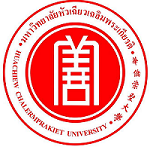Please use this identifier to cite or link to this item:
https://has.hcu.ac.th/jspui/handle/123456789/4708| Title: | A One-Year Prospective Cohort Study of SARS-CoV-2 Infection and Sociodemographic Factors in Thailand |
| Authors: | Chakkaphan Runcharoen Insee Sensorn Nuttakant Nontawong Suwannee Surattanasophon Thitiya Boonprakob Suchada Chowplijit Vachara Chuapaknam Wasun Chantratita จักรพันธุ์ รุณเจริญ อินทรี เสนสอน ณัฏฐกานต์ นนทวงค์ สุวรรณี สุรัตนโสภณ ทิติยา บุญประกอบ วสันต์ จันทราทิตย์ Huachiew Chalermprakiet University. Faculty of Medical Technology Mahidol University. Faculty of Medicine Ramathibodi Hospital Prachathipat Hospital Saraburi Regional Hospital Prachatipat Hospital Vichaivej International Hospital (Samut Sakhon) Vichaivej International Hospital (Samut Sakhon) Mahidol University. Faculty of Medicine Ramathibodi Hospital |
| Keywords: | โคโรนาไวรัส Coronaviruses โควิด-19 (โรค) COVID-19 (Disease) SAR-CoV-2 Severe Acute Respiratory Syndrome-Coronavirus-2 ไวรัสซาร์ส-โควี-2 ซาร์ส (โรค) การระบาดใหญ่ของโควิด-19, ค.ศ. 2020-2023 COVID-19 Pandemic, 2020-2023 ปัจจัยทางสังคมประชากร Sociodemographic factors การศึกษาแบบกลุ่มประชากรตามแนวโน้ม Prospective cohort study ระบาดวิทยา Epidemiology ไทย – ประชากร Thailand -- Population |
| Issue Date: | 2025 |
| Publisher: | มหาวิทยาลัยมหิดล |
| Citation: | Thai Journal of Public Health 55, 2 (May-Aug 2025) : 1299-1316. |
| Abstract: | Objective: COVID-19 was declared a global health emergency in January 2020 and a pandemic in March 2020. Although its clinical features and risk factors have been widely studied, most research has relied on retrospective or cross-sectional data, limiting insight into asymptomatic or mildly symptomatic cases. This study aimed to assess the occurrence of SARS-CoV-2 infection and its association with sociodemographic factors in a Thai population. Method: A one-year prospective cohort study was conducted from October 2021 to November 2022 at Prachatipat Hospital, Pathum Thani (N = 202), and Vichaivej International Hospital (Samut Sakhon), Samut Sakhon (N = 212). Adults aged 18–65 years who were asymptomatic at baseline were enrolled and completed self-administered questionnaires at five time points. Sociodemographic, clinical, and vaccination data were analyzed for associations with infection. Results: The cumulative incidence of SARS-CoV-2 infection was 47% at Prachatipat Hospital and 40% at Vichaivej International Hospital (Samut Sakhon). Reinfections occurred in 5.3% and 17.9% of participants, respectively, with no relapses reported. Genomic surveillance identified Delta and Omicron as the predominant variants during the study period. Common symptoms included cough, sore throat, fever, runny nose, and fatigue. Higher infection rates were observed among healthcare workers and individuals with specific sociodemographic profiles. Conclusion: These findings provide important insights into infection patterns and risk factors across diverse Thai populations and may support more targeted public health strategies. |
| Description: | สามารถเข้าถึงบทความฉบับเต็ม (Full Text) ได้ที่ : https://he02.tci-thaijo.org/index.php/jph/article/view/269466/188218 |
| URI: | https://has.hcu.ac.th/jspui/handle/123456789/4708 |
| Appears in Collections: | Medical Technology - Articles Journals |
Files in This Item:
| File | Description | Size | Format | |
|---|---|---|---|---|
| A-One-Year-Prospective-Cohort-Study-of-SARS-CoV-2-Infection-and-Sociodemographic-Factors-in-Thailand.pdf | 297.17 kB | Adobe PDF | View/Open |
Items in DSpace are protected by copyright, with all rights reserved, unless otherwise indicated.
